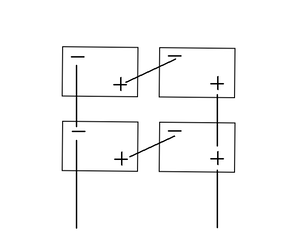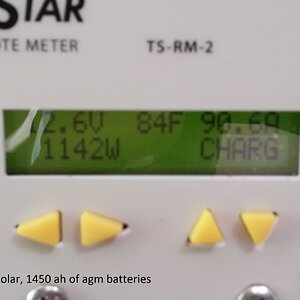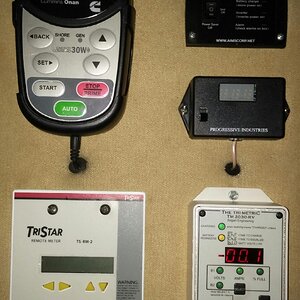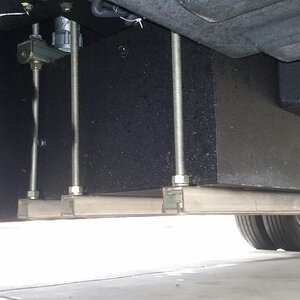Is it possible, then, that they were constantly being overcharged? I could understand one battery going bad in a relatively short period, but four going bad kind of points to some external cause.
Not trying to find blame here, but since the battery system in your previous coach was put together by you, I'm wondering if there was a mismatch between components. Engineering a 12 VDC system can be tricky and especially when retrofitting it into a coach that initially came with a different system.
TJ
I’ll be the first to agree that 4 batteries going bad at the same time is highly unlikely. To be honest, lately I've begun to wonder if they hadn't been damaged somewhere along the line, prior to my receiving them?
Attached is a diagram of how I wired them, let me know if something looks incorrect. The AIMS inverter/charger was brand new, but I guess that doesn't guarantee it is working correctly. But at the same time I installed the batteries and the AIMS, I also installed the shunt/monitor so I could monitor them, and everything always looked normal to me.
Except for 1 trip to the local campground, the coach was always connected to shore power, and on that trip, I made sure to monitor the batteries and to run my generator when the SOC started getting low. I tracked everything and kept detailed notes of it all. Upon return, we parked the coach and connected to shore power. And although I didn’t look at the monitor every day, I did check it from time-to-time, and it always looked normal.
When the new coach arrived, I removed the AIMS, the batteries and some other switches and wiring from the older coach. While the batteries were out, I tested each one individually (different charger) and that’s when I noticed each battery was slightly under 6 volts.
I took the batteries back to the dealer, he put them on his charger for a few days, and then called and said they were fine. I reinstalled them in the new coach, minus the shunt and monitor and that’s where they sat for several weeks. The coaches display always indicated a full set of bars so I assumed the batteries were charged and OK. To be sure I put a handheld tester on them and they always indicated a full charge.
Not long ago, I installed a solar controller in the basement but hadn't wired it to the solar panels yet. I turned off the shore power to watch the LED on the controller and I noticed the batteries were indicating a low charge. (Note: At the time, there was an electric heater in the coach which drew hard on the inverter/batteries.) I then hooked up the shunt and meter and started to run some tests.
And that’s how we got to where we are today. Probably more information than you needed but there you go.

The batteries indicate a full charge until I put a load on them, and then they start to discharge abnormally fast.
So, I guess they could have been overcharged, but they’ve always been treated well when in my possession. Perhaps the store caused some damage when I took them back to be inspected? At the time I picked them up he told me that he had to “blast” them for a couple of days to get them to respond but that they were fine now. So maybe they suffered some damage at that time. All I know for sure is they were treated well while in my possession..
Let me know if the diagram looks OK to you.
Thanks!













